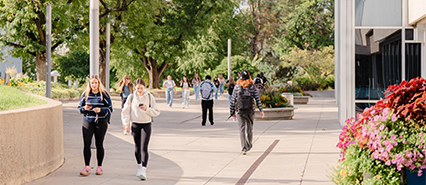Emergency Flip Chart
-
Emergency Contacts
In Case of Emergnecy Dial 911
Campus Safety & Parking..................... 719.549.2373
Non-emergency/ Pueblo County
Sheriff’s Office (PCSO)......................... 719.583.6250Student Health & Counseling Center... 719.549.2830
Campus Main Number ........................ 719.549.2100
Campus Safe Walk Program................ 719.549.2373
Environmental Health &
Safety Officer/Designee........................ 719.549.2211Pueblo Crimestoppers (Tip Line)......... 719.542.7867
Campus Crime Tip Line(Confidential Message Line)................. 719.549.2376
CSU-Pueblo Home Page............. www.csupueblo.edu
-
Weather Emergencies and Campus Closure Info
Tornadoes
- Take shelter in a basement or the smallest, most interior room or hallway on the lowest level.
- Avoid glass enclosed places or areas with wide span roofs such as auditoriums and gymnasiums.
- Crouch down and cover your head.
- DO NOT try to leave campus in your vehicle or on foot.
- Wait for instructions from authorized personnel.
Campus Closure Information
The decision to close the University due to inclement
weather will be made by the University and will be
posted online at http://www.csupueblo.edu,
via social media, and shared with local media,
television, and radio stations.A message will be sent via the emergency text
message system for any campus closure. -
Medical Emergencies
In The Event of A Medical Emergency
- Remain calm and call 911
- The call will go to the Pueblo County Sheriff’s Office Communications Center.
- Immediately identify your location
at CSU-Pueblo- Provide:
- Your name and telephone number.
- Location of the incident/accident and
the nature of the illness or injury. - The communications officer will then
send the appropriate personnel to
the scene.
- Provide:
- DO NOT move the injured person
or give first aid unless you are
trained and certified to do so.- Remain with the injured person.
- Try to keep them calm and alert by
talking until emergency responders
arrive.
- Remain calm and call 911
-
Person or Circumstance of Concern
Suspicious Activity
- Call 911 regarding a person or
circumstance of concern, including:- Persons who are behaving erratically.
- Persons believed to be under the
influence of alcohol or drugs. - Persons carrying weapons.
- Once reported remain calm
and, if possible, leave the area.
The PCSO will investigate the report and,
if necessary, the campus will be placed on
lock down status. - During the lock down status,
staff and students should
secure the room door immediately.- If you can’t secure the door to the room
you occupy, you may have to put a desk
or other object against the door. - Keep quiet and remain at that location
until instructed otherwise by the PCSO
or other law enforcement.
- If you can’t secure the door to the room
- Call 911 regarding a person or
-
Fire
Fire
- Alert people in the immediate area of the fire and evacuate.
- Activate the fire alarm at the nearest pull station.
- Evacuate the building.
- Notify the PCSO or call 911 immediately. Always call from a safe location.
- Do not use elevators unless specifically directed to do so by authorized personnel.
- If smoke, heat, or flames block your exit routes, stay in the room with the door closed.
- Stay away from glass or windows.
- Do not re-enter the building until instructed to do so by authorized personnel.
-
Bomb Threat
All bomb threats are to be
taken seriously.Call the PCSO at 911 immediately.
If you receive a bomb threat by telephone,
remain calm, write down the caller’s exact words
and note the time of the call.Ask the caller:
- When is the bomb going to explode?
- Where is the bomb?
- What does it look like?
- What kind of bomb is it?
- What will cause it to explode?
- Did you place the bomb?
- What is your name and address?
If you receive a bomb threat in written form:
- Do a quick visual inspection of your area.
- Do not touch any suspicious objects.
- Do not use radios, pagers or cell phones
as they can trigger explosive devices. - Go to a safe area and call 911.
about the incident with you. -
Evacuating Persons with Disabilities
Faculty, staff and students should be proactive and aware of people who will need assistance.
Assisting Blind / Visually Impaired:- Clearly announce the type of emergency.
- Offer your arm for guidance.
- Tell the person where you are going, and alert him or her to obstacles along the way.
Assisting Deaf / Hearing Impaired:
- Get the person’s attention using visible
communication or touch. - Indicate directions with gestures or a written note.
- Ask if they need assistance.
- Elevators should not be used. Please find the
nearest stairway. - Do not attempt to lift a person out of a wheelchair.
- Ask if they need assistance, If so, seek volunteers
to assist persons with physical disabilities to the
nearest enclosed stairway or designated area for
rescue assistance. - Others should advise emergency personnel of
the location of the individual(s) so that
evacuation can be completed. - If an imminently dangerous situation exists and
the person needs assistance to evacuate before
emergency personnel arrive, find volunteers
to help evacuate the person.
-
Hazardous Material / Natural Gas Leak
Hazardous Material Spill:
Signs are posted outside all rooms containing
hazardous materials or equipment.Only qualified personnel should handle an accidental
spill of hazardous materials.If you discover a spill, remain calm.
Do not touch the material.
If possible, isolate the area by blocking it off or
closing the doors.Call 911 with the following information:
- Where did the spill occur?
- What was spilled?
- How much was spilled?
- Are there any injuries?
If the spill occurs inside the building,
pull the closest fire pull station
and follow evacuation procedures.If the spill occurs outside a building,
evacuate the area around the spill.- Emergency responders will
provide further instructions.
Natural Gas Leak:
CAUTION – DO NOT use a phone or
any type of electronic devices
near the suspected leak area.Immediately evacuate the building and
areas in the vicinity of the suspected leak.Notify PCSO at 549-2373 AND
the Facility Services Office at 549-2211.Make sure that all evacuees are
at least 5,000 feet away from the building.DO NOT re-enter the building until you have
been instructed to by emergency personnel.The Environmental Health and Safety Officer/Designee
will consult with campus administration about
the need to close a specific campus building or
the entire campus. -
Active Assailant
Active Assailant
- Avoid
- Starts with your state of mind. Always be aware of your surroundings. Know the exits to the buildings, offices, classrooms, etc. you are in and have a primary and secondary exit plan.
- If possible, evacuate or avoid the area as quickly as possible. Move away from the threat as quickly and safely as possible.
- Contact 911.
- Provide descriptions, locations, any information that may be pertinent to law enforcement personnel.
- DENY
- LOCKDOWN
- Lights off, doors locked, seek cover, barricade the room you are in if possible.
- Silence your cell phones.
- Keep any occupants calm, quiet and out of sight.
- Ignore any fire alarms.
- Deny access to your location and create space between yourself and the assailant.
- LOCKDOWN
- DEFEND
- If you are unable to avoid and deny, be prepared to defend yourself.
- Be aggressive, using any means possible to fight off the attacker.
- Improvise weapons and be committed to your actions.
- You have the right to defend yourself.
Remember: First responding officers WILL NOT STOP to aid wounded or injured. They will continue on to stop the threat.
Once officers arrive at your secured location, keep your hands empty and in plain view at all times.
- Follow the officer’s directions exactly and carry nothing that could be mistaken for a weapon.
- Rescue teams will arrive after the first responding officers and move everyone to a safe area.
- Keep quiet and remain at that location until instructed otherwise by the PCSO or other law enforcement agency.
Active Assailant Response includesANY and ALL Weapons!Contact 911 ImmediatelyYou can also contact CSU Pueblo County Sheriff’s Office at 719-549-2373.An alert notification will be made with instructions. - Avoid


